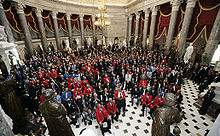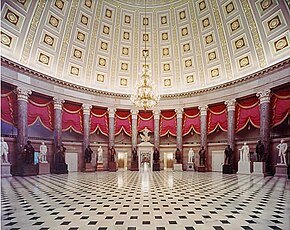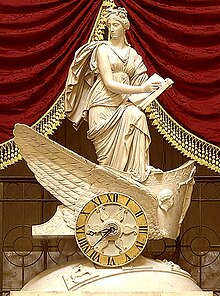National Statuary Hall

The National Statuary Hall is a room in the United States Capitol in Washington, DC that exhibits statues of prominent Americans . The hall, also known as the "Old Hall of the House", is a large, two-story, semicircular room with a large dome. It is located south of the rotunda . The hall was the meeting room of the United States House of Representatives from 1807 to 1857 and is now the main exhibition space of the National Statuary Hall Collection .
description
The room is built in the shape of an ancient amphitheater and is one of the earliest examples of neoclassical architecture in America. While most of the wall surfaces are made of painted plaster, the gallery's lower walls and pilasters are made of sandstone . Around the room are colossal columns of variegated breccia - marble , along the Potomac River was mined. The white marble Corinthian capitals were cut in Carrara ( Italy ). A skylight in the fireproof cast iron ceiling lets natural light into the hall. The floor is covered with black and white marble. The black marble was bought extra, while the white marble is the remains of the expansion measures at the Capitol.
Only two of the many statues that are now in the hall were originally commissioned for the plenary hall of the House of Representatives. Enrico Causici's plaster statue, Liberty and the Eagle, overlooks the hall from an alcove behind the podium for the Speaker of the United States House of Representatives . The sandstone eagle was carved by Giuseppe Valaperta. Carlo Franzoni's Car of History is located above the door to the Rotunda . This neoclassical marble sculpture shows Klio , the muse of history, who drives in the carriage of time and notes the events below. In the wagon wheel is the clock, a work by Simon Willard . If you stand a little south of the chandelier, you can see the Statue of Freedom through the skylight .
It is reported that John Quincy Adams used the room acoustics to overhear conversations on the other side of the room. This can still be tested today.
history
The room is the second plenary hall and the third meeting place of the House of Representatives in this location. Previously, the members gathered in a squat, oval building called "the furnace," which was hastily erected in 1801. The first permanent plenary hall, designed by Benjamin Henry Latrobe , was completed in 1807. It was destroyed in 1814 when British troops burned the Capitol in 1814 during the War of 1812 . The hall was rebuilt in its current form by Latrobe and his successor Charles Bulfinch between 1815 and 1819. However, the smooth, vaulted ceiling encourages annoying echoes that make communication difficult. Various attempts to improve the acoustics, e.g. B. curtains or a changed seating arrangement were unsuccessful. The only solution to this problem was to build a new chamber so that the debates could be better understood. This new hall was approved in 1850 and in 1857 the House of Representatives moved into the current plenary hall in the new wing of the building.
Many important events took place in this room when it was used by the House of Representatives. In 1824, the Marquis de Lafayette was the first foreign citizen to speak before Congress here. Presidents James Madison , James Monroe , John Quincy Adams, Andrew Jackson and Millard Fillmore were sworn in here . Adams in particular was associated with the Chamber for a long time. In the presidential election of 1824 none of the candidates won a majority of the electoral vote. Now the vote of the House of Representatives was decisive, which surprisingly elected Adams, who ruled for four years. In 1831 he was elected to the House of Representatives. He belonged to this for 17 years until his death. On February 21, 1848, he suffered a stroke during a debate. Two days later he died in his adjoining office.


The fate of the vacant space was uncertain for a long time, although numerous suggestions for use were made. The simplest solution would have been to use the Library of Congress , which was still in the Capitol. More drastic was the proposal to tear down the whole hall and replace it with two floors of committee rooms. Eventually the use of the space as an art gallery was approved and works of art intended for the annexes to the Capitol were exhibited there. This included the plaster model of the Statue of Freedom , which was later cast in bronze for the Capitol's dome. Since there was little wall space, no large paintings could be hung. However, the room seemed suitable for displaying statues.
In 1864, Congress invited all states to donate two statues of prominent citizens for exhibition in the hall. The new name of the room was now National Statuary Hall. The floor was leveled and the marble tiles that can still be seen today were laid. At the beginning of the 20th century, the original wooden ceiling, the painting of which simulated a three-dimensional coffered ceiling, was replaced by the current ceiling. This eliminated most of the echoes that were previously annoying.
The first statue was erected in 1870, in 1971 all 50 states had donated at least one statue, and by 1990 45 states had donated two statues. At the beginning, all statues were in the National Statuary Hall. Over time, the collection grew and became too big for the space. In 1933, the display of exhibits throughout the Capitol was approved by Congress. Today there are 38 statues in the National Statuary Hall.
In 1976 the room was partially renovated for the bicentenary. At this time, the original chimneys were revealed and replicas of the original mantels were put in place. Reproductions of the chandeliers, sconces and red curtains were made from the old oil painting The House of Representatives by Samuel FB Morse , painted in 1822. The painting is now hanging in the Corcoran Gallery of Art . In the floor were bronze plaques in honor of the presidents who were in the House of Representatives at the time it was in session.
Today the Statuary Hall is one of the most visited rooms in the Capitol. It is viewed by hundreds of visitors every day and continues to be used for special occasions. These include events in honor of foreign dignitaries and lunch, to which Congress invites the newly sworn president every four years.
Statues
The following list shows the depicted people and the state that donated the statue:
- Samuel Adams , Massachusetts
- Ethan Allen , Vermont
- William Allen , Ohio (removed in favor of Thomas Edison in 2016)
- Stephen F. Austin , Texas
- Charles Brantley Aycock , North Carolina
- Bob Bartlett , Alaska
- William Henry Harrison Beadle , South Dakota
- Thomas Hart Benton , Missouri
- Francis Preston Blair , Missouri
- William Edgar Borah , Idaho
- Norman Borlaug , Iowa
- William Jennings Bryan , Nebraska
- John Burke , North Dakota
- John C. Calhoun , South Carolina
- Charles Carroll , Maryland
- Lewis Cass , Michigan
- Zachariah Chandler , Michigan (removed in 2011 in favor of Gerald Ford)
- Dennis Chavez , New Mexico
- James Paul Clarke , Arkansas
- Henry Clay , Kentucky
- John Middleton Clayton , Delaware
- George Clinton , New York
- Jacob Collamer , Vermont
- Jabez Lamar Monroe Curry , Alabama (removed in favor of Helen Keller in 2009)
- Damian de Veuster , Hawaii
- Jefferson Davis , Mississippi
- Thomas Edison , Ohio
- Dwight D. Eisenhower , Kansas
- Philo Farnsworth , Utah
- Gerald Ford , Michigan
- Robert Fulton , Pennsylvania
- James A. Garfield , Ohio
- James Z. George , Mississippi
- George Washington Glick , Kansas (removed in favor of Dwight D. Eisenhower in 2003)
- Barry Goldwater , Arizona
- John Gorrie , Florida
- Nathanael Greene , Rhode Island
- John Campbell Greenway , Arizona (removed in 2015 for Barry Goldwater)
- Ernest Gruening , Alaska
- Hannibal Hamlin , Maine
- Wade Hampton , South Carolina
- John Hanson , Maryland
- James Harlan , Iowa (removed in favor of Norman Borlaug in 2014)
- Sam Houston , Texas
- John James Ingalls , Kansas
- Andrew Jackson , Tennessee
- Mother Joseph du Sacré-Cœur , Washington
- Kamehameha I. , Hawaii
- Philip Kearny , New Jersey
- Helen Keller , Alabama
- John E. Kenna , West Virginia
- Thomas Starr King , California (removed in favor of Ronald Reagan in 2009)
- William King , Maine
- Eusebio Francisco Cinema , Arizona
- Samuel Jordan Kirkwood , Iowa
- Robert M. La Follette , Wisconsin
- Jason Lee , Oregon
- Robert Edward Lee , Virginia
- Robert R. Livingston , New York
- Crawford Williamson Long , Georgia
- Huey Pierce Long , Louisiana
- Jacques Marquette , Wisconsin
- Pat McCarran , Nevada
- Ephraim McDowell , Kentucky
- John McLoughlin , Oregon
- Esther Hobart Morris , Wyoming
- Julius Sterling Morton , Nebraska
- Oliver Hazard Perry Throck Morton , Indiana
- Peter Muhlenberg , Pennsylvania
- Francis Harrison Pierpont , West Virginia
- Po'pay , New Mexico
- Jeannette Rankin , Montana
- Ronald Reagan , California
- Henry Mower Rice , Minnesota
- Caesar Rodney , Delaware
- Will Rogers , Oklahoma
- Uriah M. Rose , Arkansas
- Charles M. Russell , Montana
- Florence Rena Sabin , Colorado
- Sacajawea , North Dakota
- Maria Sanford , Minnesota
- Sequoyah , Oklahoma
- Junípero Serra , California
- John Sevier , Tennessee
- Roger Sherman , Connecticut
- James Shields , Illinois
- George Laird Shoup , Idaho
- Edmund Kirby Smith , Florida
- John Stark , New Hampshire
- Alexander Hamilton Stephens , Georgia
- Richard Stockton , New Jersey
- John Leonard Swigert , Colorado
- Jonathan Trumbull , Connecticut
- Zebulon Baird Vance , North Carolina
- Lew Wallace , Indiana
- Joseph Ward , South Dakota
- Washakie , Wyoming
- George Washington , Virginia
- Daniel Webster , New Hampshire
- Joseph Wheeler , Alabama
- Edward Douglass White , Louisiana
- Marcus Whitman , Washington
- Frances Willard , Illinois
- Roger Williams , Rhode Island
- Sarah Winnemucca , Nevada
- John Winthrop , Massachusetts
- Brigham Young , Utah
Web links
- US Capital Website: National Statuary Hall
- [1] The Capitol and Congress - Art and History
Individual evidence
- ^ The Splendid Hall: The Hall of the House of Representatives (1807û1857) . In: Historical Highlights: Virtual Tours . Clerk of the United States House of Representatives . November 7, 2003. Archived from the original on September 28, 2006. Info: The archive link was automatically inserted and has not yet been checked. Please check the original and archive link according to the instructions and then remove this notice. Retrieved September 25, 2006.
- ↑ a b c d e f g h i National Statuary Hall (The Old Hall of the House) . In: Capitol Complex . Architect of the Capitol . Retrieved September 25, 2006.
- ↑ "the Oven" ( Memento of the original from March 4, 2011 in the Internet Archive ) Info: The archive link was inserted automatically and has not yet been checked. Please check the original and archive link according to the instructions and then remove this notice.



